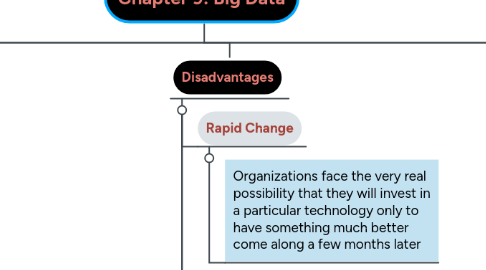
1. Definition
1.1. The collection of all this data and our ability to use it to our advantage across a wide range of areas, including business (Bernard Marr, 2019).
2. Characteristics
2.1. Volume
2.1.1. The amount of data (which, sometimes, can reach almost incomprehensible proportions)
2.2. Velocity
2.2.1. Measures how fast the data is coming in
2.3. Variety
2.3.1. Data today comes in all types of formats; Structured (numeric data in traditional databases) and Unstructured (text documents, email, video)
3. Advantages
3.1. Educational Sector
3.1.1. Dropout rates in schools or colleges can be reduced
3.1.2. Help the student to choose a right college and course for their own future
3.1.3. Predict applicants and analyze the factors that affects the application process
3.2. Business Sector
3.2.1. A business decision-makers will get analytics of the data-driven insights they need to help their companies compete and grow
3.2.2. Using big data can decrease expenses for its operational efficiency
3.3. Modern big data tools quickly allows more analysts of data which increases their personal productivity
4. Disadvantages
4.1. Rapid Change
4.1.1. Organizations face the very real possibility that they will invest in a particular technology only to have something much better come along a few months later
4.2. Cybersecurity Risks
4.2.1. Storing big data can make companies a more attractive target for cyberattacks
4.3. Costs
4.3.1. Enterprises face significant expenses related to staffing, hardware, maintenance and related services
5. Practices and Application
5.1. Banking and Securities
5.1.1. Card fraud detection and audit trails
5.1.2. Enterprise credit risk reporting
5.1.3. Customer data transformation and amalytics
5.2. Communications, Media and Entertainment
5.2.1. Leveraging mobile and social media content
5.2.2. Understanding patterns of real-time, media content usage
5.3. Healthcare Providers
5.3.1. Rising medical costs
5.3.2. Unavailability data
5.4. Education
5.4.1. Incorporation data from varied sources
5.4.2. Issues of privacy and data protection
5.5. Manufacturing and Natural Resources
5.5.1. Large volumes of untapped data from the manufacturing industry
5.6. Goverment
5.6.1. Intergration
5.6.2. Interoperability of big data
5.7. Insurance
5.7.1. Hunger for better insight
5.8. Retail and Wholesale Trade
5.8.1. Unutilized Data derived from customer loyalty cards, POS scanners and RFID etc
5.9. Transportation
5.9.1. Transport demand models are still based on poorly understood new social media structured
5.10. Energy and Utilities
5.10.1. Global installed wind capacity increased by 12.4%

